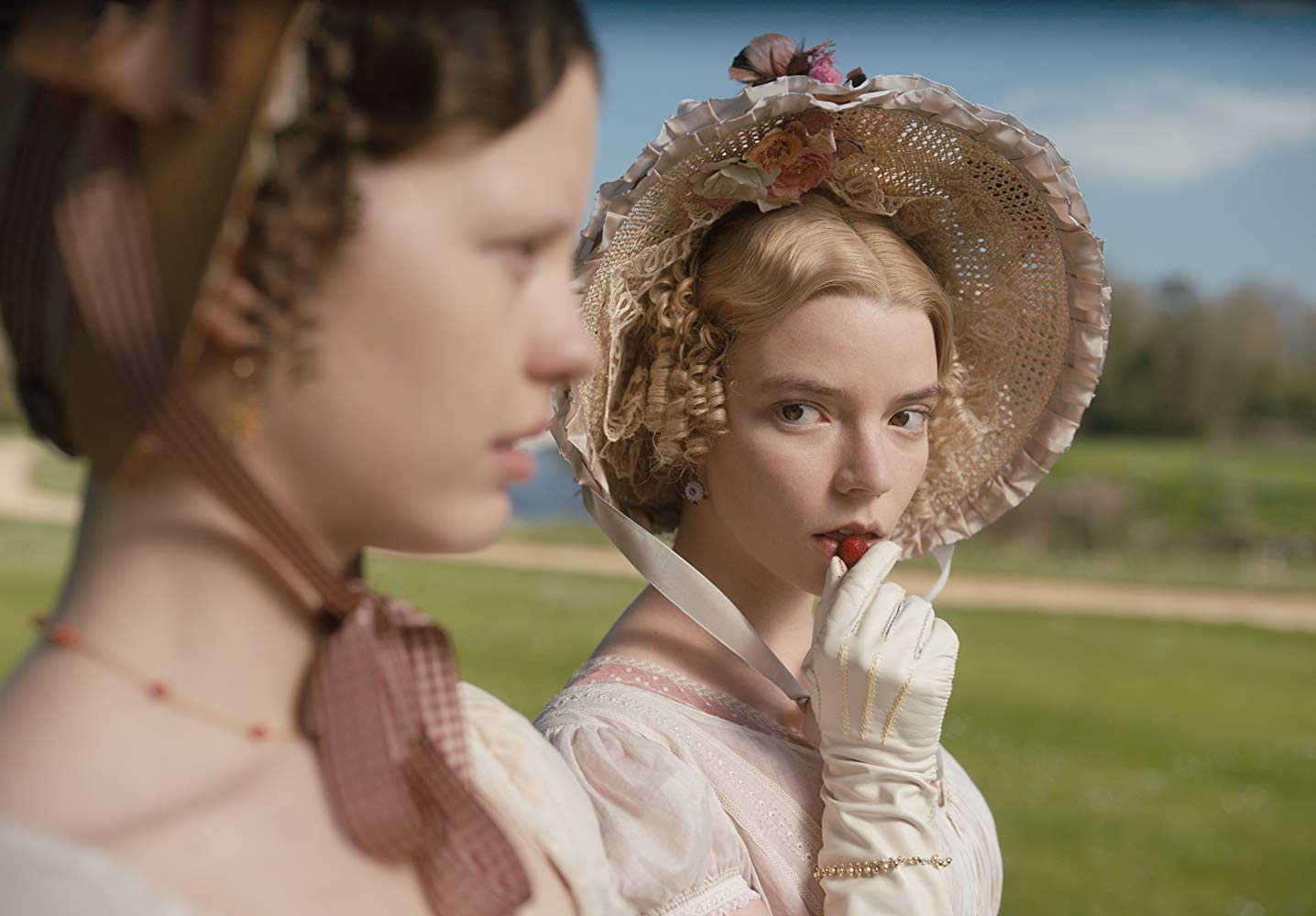Quivering Bodices and Bonnets: Female Desire in Autumn de Wilde’s Emma

For many young readers, especially young women readers, Jane Austen is the gateway to romance. Through the pages of such titles as Pride & Prejudice, Sense & Sensibility, and of course, Emma, we’re greeted with a version of romance that seems to be all glances exchanged across crowded ballrooms and wealthy, handsome heroes riding up in their frilly shirts on snow white horses. It’s a gateway because it’s a safe jumping off point—hot, and yet not explicit, contained within the same polite society that the characters were written into.
So, what happens when innocent page turning grows up and needs a little something-something more? If you’re lucky, you get Autumn de Wilde’s directorial debut and latest Austen adaptation for the screen, Emma. Hang onto your bonnets, because this film understands and delivers on female desire!
The genre of romance, in film and literature, has always found a special place among women. 84% of all readers of the genre are, in fact, women, and historical writers like Austen put down strong roots for women creators in the genre. Autumn de Wilde taps into female desire in her 2020 adaptation of Emma, working deftly within that constrained and fantasy-like romance of Austen’s time while also, to be frank, bringing an air of horniness to the picturesque halls of the fictional Hartfield.
Emma stars Anya Taylor-Joy as the “clever, handsome, and rich” titular heroine, alongside Johnny Flynn and Bill Nighy. The film faithfully adapts the original novel, centered on the romantic misadventures of Emma herself. She’s a privileged young woman who fancies herself a matchmaker, and her interference into the love lives of her friends and loved ones triggers a comedy of errors, confusion, attraction, and love desperately sought and (in some cases) unrequited.
One of the great triumphs of this adaptation of Emma is that it manages to be simultaneously faithful to the aesthetics and structure of the Georgian era and the period piece genre, while also being so refreshingly contemporary. A huge part of this is born out of highly sexed imagery that is not so common within the rest of the genre and very heavily coded for female desire. The male gaze is blissfully absent from Emma.
Expected scenes of female preening before a ball are replaced with the male version. The film teases the sexual undertones of these typically chaste Austen romances with sparing but titillating scenes featuring male nudity. It’s the Colin Firth swimming scene from Pride and Prejudice, only… more so.
Beyond the more blatant eye candy, Emma has a fixation on showing its titular character as coming into “bloom.” Often, Emma is shown dressed in florals and surrounded by flowers in her greenhouse. As the film progresses, her dress becomes more vibrant, and the closed buds she gently touches to her lips become fully blossomed flowers. This preoccupation with lips and the opening up of a flower come across as a sensual shorthand. The closer Emma gets to her own romance being fulfilled, the more open she is to her own bodily desire.
It’s not just Emma who is caught in the throes. Her friend, Harriet, when rescued by a dashing fellow, delivers every line of dialogue in a breathy lampoon of orgasm. It’s absurd to the point of being hilarious, but once again, brazenly feminine and brazenly sexual. What makes Emma so fun is how comfortable it is showing the ridiculous side of desire. Horny feels like a crass word to continue to use in describing a period piece, but it’s apt.
We may think of the Georgian period in terms of its tight-laced morals and restrictive social code. However, as with any moment in human history, the Georgian period had its own fair share of dirty jokes. Scandals of infidelity were front page news, and art and theatre of the period provided a much needed outlet for those buttoned-up desires.
Emma does what many other films focused on this time period do not and leans into the bawdiness of the era. In one particular scene, the object of Emma’s desire, Mr. Knightley, sings Drink to Me Only With Thine Eyes as part of a piano duet with Emma’s rival. While the excerpt shown in the film is short, the song, in a historical context, is another example of blatant sexual desire. The movie stops things after the first few lines, but just before this section that immediately follows:
The thirst that from the soul doth rise
Doth ask a drink divine.
Why does this matter? Because this is a scene about desires not yet spoken and the question of whether passion is shared. It’s a brilliant intersection of a historical love song and the very modern notion of “thirst,” calling out Emma’s very real thirst for Mr. Knightley.
Emma competently and confidently injects a very honest discussion of sex and desire into the conservative period piece. The world of Austen has long resonated with women as a classic example of safe, chaste romance. It’s high time for a reimagining of what a love story should actually look like for women, full of desire and with the female icons of literature taking their sexual agency by the reins.
Emma opened on Valentine’s Day in the UK and hits wide release in the U.S. tonight.
Want more stories like this? Become a subscriber and support the site!
—The Mary Sue has a strict comment policy that forbids, but is not limited to, personal insults toward anyone, hate speech, and trolling.—
Have a tip we should know? tips@themarysue.com